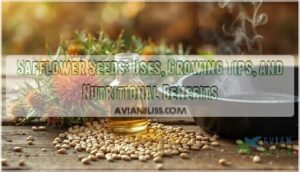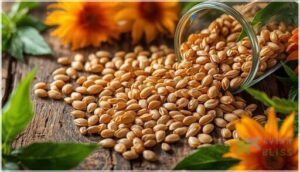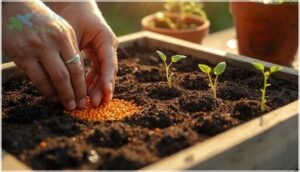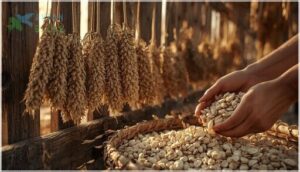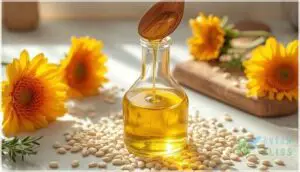This site is supported by our readers. We may earn a commission, at no cost to you, if you purchase through links.
Most gardeners know sunflower seeds, but fewer recognize their ancient cousin: safflower seeds. These small, white kernels come from Carthamus tinctorius, a resilient, thistle-like plant that’s been cultivated for over 4,000 years across hot, arid regions.
What makes them stand out isn’t just their impressive nutritional profile—with 38 grams of fat per 100 grams and a hefty 517 calories—but their versatility. You’ll find safflower seeds pressed into high-smoke-point cooking oil, scattered in bird feeders to attract cardinals while deterring squirrels, and even used as an affordable stand-in for saffron’s golden hue.
Whether you’re considering growing them in your garden or simply curious about their culinary and nutritional merits, understanding safflower seeds opens up practical possibilities you might not have expected.
Table Of Contents
- Key Takeaways
- What Are Safflower Seeds?
- Nutritional Value of Safflower Seeds
- Planting and Growing Safflower for Seeds
- Using Safflower Seeds for Bird Feeding
- Safflower Seed Oil and Human Consumption
- Market Trends and Production of Safflower Seeds
- Frequently Asked Questions (FAQs)
- What birds will not eat safflower seeds?
- What are the benefits of safflower seeds?
- Do birds prefer sunflower or safflower seeds?
- Do rodents eat safflower seeds?
- What is safflower seed used for?
- Why is safflower seed so expensive?
- Can safflower seeds be used for sprouting?
- Do safflower seeds need special storage conditions?
- Are there different varieties of safflower seeds?
- What are the environmental impacts of safflower cultivation?
- Conclusion
Key Takeaways
- Safflower seeds pack 517 calories per 100 grams with 38 grams of fat, making them an energy-dense food source that’s been cultivated for over 4,000 years across hot, arid regions where other crops struggle.
- You can use safflower seeds in three practical ways: press them into high-smoke-point cooking oil rich in omega-6 fatty acids that support heart health, scatter them in bird feeders to attract cardinals while deterring squirrels by up to 70%, or substitute safflower petals for saffron’s golden color at less than 1% of the cost.
- Growing safflower requires well-drained soil with pH near 6.0, full sunlight, and temperatures between 50–85°F for germination, with the crop thriving in semi-arid zones that receive 300–600 mm of rainfall annually.
- The global safflower market is projected to grow from $1.2–$1.5 billion in 2025 to $15.2 billion by 2029, driven by demand for healthier cooking oils and the plant’s drought tolerance, with Kazakhstan leading production at 238,000 metric tons annually.
What Are Safflower Seeds?
Safflower seeds come from a bright, thistle-like plant that’s been cultivated for thousands of years across different continents.
These small, white seeds pack a surprising amount of versatility, serving everyone from home gardeners to bird enthusiasts to health-conscious cooks.
Let’s break down what makes these seeds unique, starting with their botanical roots and moving through their rich history and distinct physical traits.
Botanical Description and Origin
Safflower, known scientifically as Carthamus tinctorius, is a thistle-like annual plant from the Asteraceae family. You’ll find this adaptable species reaches heights between 30 and 150 cm, producing vibrant flower heads with yellow, orange, or red florets.
Domesticated over 4,000 years ago in the Fertile Crescent, safflower thrives in hot, dry climates thanks to its deep taproot system. Valued by ancient civilizations, safflower was used to dye textiles.
Most cultivated varieties are self-compatible, ensuring reliable seed germination and viability even in challenging conditions.
Historical and Culinary Uses
For thousands of years, you’ve seen safflower serve as a natural dye and culinary treasure. Ancient Egyptians tucked safflower garlands into King Tut’s tomb, while Mediterranean cultures extracted vibrant red and yellow pigments for weaving.
Safflower has served humanity for millennia as both a vivid natural dye and a versatile culinary ingredient
As a saffron substitute, it colored Spanish settlers’ rice dishes and flavored European sausages. Today, safflower oil dominates cooking applications, while traditional medicine across Asia and Africa relied on its extracts for cardiovascular and menstrual health.
The plant’s cultivation has ancient roots in the Fertile Crescent.
Physical Characteristics of The Seeds
Beyond its culinary past, you’ll notice safflower seeds range from white to dark brown in coat color, measuring roughly 0.59 mm long and 0.46 mm wide.
Seed dimensions stay stable once mature, but hull content reaches about 37% of total weight.
Density varies between 615–712.5 kg/m³, while hardness drops sharply as moisture rises—key factors affecting seed quality and viability.
Nutritional Value of Safflower Seeds
Safflower seeds pack a serious nutritional punch that makes them valuable for both wildlife and human use. Understanding what’s inside these small seeds helps explain why they’re such an effective energy source.
Let’s break down the key nutrients and calories, and how they compare to other seeds you might already know.
Macronutrient Breakdown (Protein, Fat, Carbohydrates)
When you crack open safflower seeds, you’ll find they pack a high fat content punch—about 38 grams per 100 grams, mostly from polyunsaturated fatty acids. Protein comes in at around 16 grams, while carbohydrates make up 34 grams.
This fatty acid profile means fat contributes roughly 63% of total energy, with carbohydrates at 25% and protein at 12%, creating a nutrient-dense profile.
Caloric Content and Energy Density
At 517 kilocalories per 100 grams, safflower seeds qualify as an energy-rich food you can count on. A standard one-ounce serving delivers 147 kcal—about 10% of your daily needs if you’re tracking a 1500-calorie diet. The high fat content drives most of this caloric contribution, while safflower seed oil reaches an impressive 827 kcal per 100 ml.
Defatted meal, meanwhile, drops to just 97 kcal per ounce with high protein.
Comparison to Other Common Seeds
When you line up safflower seeds against sunflower, pumpkin, or sesame, you’ll notice they hold their own in different ways. Protein comparison shows safflower at 16 grams per 100 grams—less than pumpkin’s 30 grams but still respectable.
Fatty acids lean heavily polyunsaturated, especially linoleic acid at 70.5%. Mineral content shines with 353 mg magnesium, topping sunflower and sesame, while fiber differences favor pumpkin and flax over safflower’s modest amount.
Planting and Growing Safflower for Seeds
Growing safflower for seeds is easier than you might think, especially if you understand what the plant needs to thrive. Success starts with choosing the right location and preparing your soil properly, then moves through careful planting and maintenance.
Let’s walk through the key steps to help you grow healthy safflower plants and harvest quality seeds.
Ideal Soil and Climate Conditions
You’ll want to grow safflower in well-drained loam soils with high soil water capacity, ideally at least 4 feet deep. The crop thrives when soil pH sits near 6.0, though it tolerates up to 8.0.
Safflower adapts well to regional climate variations in semi-arid zones, needing 300–600 mm rainfall and full sunlight exposure. Cool temperatures help germination, while warm growing conditions (20–30°C) support seed development.
Sowing and Germination Tips
You’ll get the best safflower seed germination by sowing directly into prepared soil when temperatures reach 50–85°F, placing seeds at 1/4 to 1 inch seed depth.
Space them 6–12 inches apart in rows, and you can pre-soak for 12–24 hours to speed things up.
Keep the soil consistently moist during germination time—expect sprouts within 7–14 days, then thin seedlings to 12–18 inches apart.
Pest and Disease Management
Your safflower crop can lose 37–74% of its yield to aphids if you don’t act early—that’s why pest and disease management matters.
Effective IPM strategies combine organic pest control and biological controls before chemical interventions:
- Monitor regularly for aphids, thrips, and Alternaria blight
- Apply neem oil or insecticidal soap to tackle infestations
- Space plants properly to reduce disease threats
- Encourage ladybugs and lacewings for natural aphid suppression
- Reduce overhead watering for better disease prevention
Harvesting and Seed Processing Techniques
Harvest timing is critical—wait until seed heads turn brown and dry, about 50–60 days after peak flowering, when seed moisture drops to around 8–10%.
Cut seed heads and hang them upside down in a well-ventilated space for thorough seed drying.
Once dry, thresh the seeds by rubbing or beating gently, then winnow to remove chaff.
Store cleaned seeds in cool, dry conditions below 21°C to preserve viability.
Using Safflower Seeds for Bird Feeding
Safflower seeds have become a popular choice for backyard bird enthusiasts who want to attract specific species while keeping unwanted visitors away. These seeds offer a unique advantage over traditional birdseed options, making them worth considering for your feeding station.
Let’s explore which birds you’ll attract, how to set up your feeders effectively, and ways to create the ideal seed mix.
Birds Attracted to Safflower Seeds
When you stock your backyard feeders with safflower, you’ll draw a vibrant variety of songbirds. Cardinal preference for these seeds is well-documented, and you’ll notice finch adaptation over time. Here are five species you can expect:
- Northern Cardinals – Their strong bills crack shells easily, boosting visits by up to 32%
- Chickadees and Titmice – Consistent visitors year-round
- House and Purple Finches – Comprise up to 25% of feeder activity
- Mourning Doves – Show strong dove consumption patterns
- Nuthatches and Woodpeckers – Nuthatch exploitation and woodpecker visits increase in winter
Safflower bird seed helps you attract diverse backyard birds naturally.
Deterring Squirrels and Unwanted Wildlife
While safflower attracts songbirds, it’s popular as a squirrel deterrent because of its bitter taste. Studies show squirrel visits drop by 50% at safflower feeders. However, some species, like chipmunks and fox squirrels, may adapt over time. For best results in managing backyard pests, combine the benefits of safflower seeds with strategic feeder placement and physical barriers, achieving up to 80% reductions in unwanted wildlife.
| Strategy | Pest Reduction | Economic Outcomes |
|---|---|---|
| Safflower only | 30% fewer mammals | 25% less seed loss |
| Physical barriers | 55% decline | 60% less feeder damage |
| Combined approach | 80% reduction | 20% cost increase |
To maximize the effectiveness of discouraging pests, avoid mixing safflower with sunflower seeds.
Best Practices for Bird Feeder Placement and Maintenance
Beyond using safflower seeds as a squirrel deterrent, proper bird feeder management ensures you’re attracting birds with safflower successfully. Feeder location matters greatly for collision reduction and visitor safety. Here are three essential placement practices:
- Set feeder height at 5–6 feet to minimize predator access while maintaining easy bird visibility.
- Maintain cover proximity of 10–12 feet from shrubs for quick escape routes.
- Follow cleaning frequency guidelines of every two weeks to preserve seed quality and prevent disease transmission.
Mixing Safflower With Other Bird Seeds
When you’re thinking about bird seed mixes, you don’t have to go all-in on safflower alone. Blending it with sunflower or millet balances nutritional impacts while broadening species preferences—commercial bird seed formulas often include 15–25% safflower to keep pest deterrence strong without sacrificing appeal.
Here’s how different blends perform when attracting birds to backyard feeders:
| Seed Combination | Top Attracted Species | Pest Deterrence Level |
|---|---|---|
| Safflower + Sunflower | Cardinals, chickadees, titmice | Moderate (squirrels 40% reduced) |
| Safflower + Millet | Doves, native sparrows, grosbeaks | High (grackles 35–50% avoided) |
| Safflower Only | Cardinals, grosbeaks | Highest (squirrels 70% reduced) |
Mixed bird food improves feeding outcomes, with year-round retention climbing 12–18% and biodiversity reaching 14 species per feeder. Market presence of safflower seed for birds keeps growing, especially in premium blends priced around $7.50–$18 per five-pound bag.
Safflower Seed Oil and Human Consumption
Safflower seeds offer more than just bird feed—they’re a valuable ingredient in your kitchen too. You can press these seeds into a multipurpose cooking oil that rivals other plant-based oils in both flavor and nutrition.
Let’s explore how safflower oil fits into human diets, what makes it beneficial for your health, and how the plant itself can stand in for one of the world’s most expensive spices.
Oil Extraction and Culinary Uses
Once you extract oil from safflower seeds, you have access to a flexible cooking ingredient with a remarkably high smoke point. Three primary extraction methods bring this oil to your kitchen: batch hydraulic pressing, continuous screw expeller pressing, and solvent extraction.
You’ll find safflower oil shines in these culinary applications:
- Deep frying without flavor alteration
- Salad dressings with neutral taste
- Margarine and processed foods
- Sautéing and roasting at high temperatures
- Industrial food production requiring stability
Health Benefits and Nutritional Properties
Safflower seed oil delivers impressive health advantages you can count on. High-linoleic varieties pack over 70% omega-6 fatty acids, supporting heart health by lowering LDL cholesterol and triglycerides. Studies show it improves diabetes management through better insulin sensitivity and reduced HbA1c. The antioxidant capacity from phenolic compounds provides anti-inflammatory effects throughout your body, while vitamin E delivers meaningful skin benefits through moisture retention and protection.
| Health Benefit | Key Effect |
|---|---|
| Heart Health | Lowers LDL cholesterol and triglycerides considerably |
| Diabetes Management | Improves insulin sensitivity and reduces blood sugar |
| Anti-Inflammatory Effects | Suppresses inflammatory markers and oxidative stress |
Safflower as a Saffron Substitute
In dishes where saffron’s golden hue matters more than its aroma, safflower petals offer an economical alternative. You’ll need roughly 2–3 times more safflower by weight to match saffron’s color intensity, but you’ll pay less than 1% of saffron’s price.
Just remember—safflower delivers the visual appeal without saffron’s distinctive flavor, making it ideal for rice and soups where color is most prominent.
Market Trends and Production of Safflower Seeds
Safflower isn’t just a backyard crop anymore—it’s become a player in the global agricultural market. A handful of countries lead production, and the industry is seeing steady growth driven by rising demand for healthy cooking oils.
Let’s look at where safflower seeds are grown, what the market looks like today, and what’s pushing this quiet crop into the spotlight.
Global Production Leaders and Statistics
When you’re looking at where safflower seeds come from, Kazakhstan stands at the top, producing 238,000 metric tons in 2024—nearly 45% of the world’s crop production. Russia follows with 153,000 tons, showing considerable agricultural practices with 12.5% growth yearly since 2013.
India, the United States, and China round out the regional shares, though market volatility has affected their yield dynamics recently.
Market Value and Growth Projections
The global safflower seeds market reached approximately $1.2 to $1.5 billion in 2025, with projections climbing to $15.2 billion by 2029. You’re seeing a steady compound annual growth rate between 6% and 6.92%, driven by consumer demand for healthier oils and innovations in crop production.
Regional analysis shows Europe and North America leading, while Asia-Pacific regions emerge as significant hubs for agricultural practices and market segmentation.
Factors Influencing Demand and Supply
What shapes the ebb and flow of safflower seeds in today’s marketplace? Several intertwined forces determine both price and quantity available:
- Climate impacts directly affect yield quality and weight of harvested seeds, with drought-tolerant varieties gaining ground in marginal growing regions
- Demand drivers include culinary uses for high-oleic oil and diverse safflower uses in cosmetics and functional foods
- Market competition from larger oilseeds like soybean influences farmer planting decisions
- Policy effects supporting sustainable agriculture and organic certification create premium market segments despite higher production costs
Frequently Asked Questions (FAQs)
What birds will not eat safflower seeds?
Some birds actively avoid bitter flavors. Grackles, European Starlings, House Sparrows, and blackbirds generally reject safflower seeds due to their sharp taste and thick shells, while squirrels also show strong aversion to them.
What are the benefits of safflower seeds?
Safflower seed benefits include heart health support through cholesterol improvement, anti-inflammatory effects from rich polyphenols, and blood sugar regulation.
Their nutritional profile offers energy-rich, nutrient-dense content, providing metabolic support for both birds and humans.
Do birds prefer sunflower or safflower seeds?
Most backyard birds show a clear preference for sunflower seeds, with over 70% choosing them first.
However, cardinals and grosbeaks particularly favor safflower seeds, making species-specific attraction key to your bird feeding strategy.
Do rodents eat safflower seeds?
Like a picky eater at dinner, most squirrels skip safflower when tastier options exist. However, rodent consumption variability means some will nibble if alternative food availability drops—seed access limitations and individual preference matter more than absolute deterrence.
What is safflower seed used for?
You can press safflower seeds for cooking oil, blend them into birdseed mixes, extract natural dyes for textiles, or use them in traditional medicinal preparations.
They’re also roasted as nutritious snacks in some cultures.
Why is safflower seed so expensive?
Several factors drive up the price of good quality safflower: production input costs run high, market price volatility adds uncertainty, supply chain barriers increase expenses, global demand continues rising, and climatic influences disrupt yields unpredictably.
Can safflower seeds be used for sprouting?
You might be surprised to learn that safflower seeds do sprout with over 85% germination viability under ideal conditions.
However, microbial risks and limited nutritional documentation mean they’re rarely used for growing edible sprouts compared to traditional sprouting seeds.
Do safflower seeds need special storage conditions?
Yes, safflower seeds need proper seed storage to maintain seed viability. Keep moisture control below 8%, use airtight container choice, and store in cool temperatures.
This seed preservation prevents spoilage risks and extends storing flower seeds lifespan effectively.
Are there different varieties of safflower seeds?
You’re not stuck with just one flavor of safflower—these seed varieties come dressed in different hulls, flower colors, and oil profiles. Oilseed varieties differ from birdseed types, and regional preferences shape which specialty cultivars farmers choose based on climate and market demand.
What are the environmental impacts of safflower cultivation?
Safflower cultivation has both positive and negative environmental impacts. It affects water usage, soil health, and biodiversity, while also producing GHG emissions from soil preparation and fertilizer use.
Its deep roots offer a significant benefit by improving soil drainage in dry soils. This characteristic supports sustainable products and promotes climate-resilient farming practices.
Conclusion
You might’ve overlooked them at the garden center or glanced past them in the bulk aisle, but safflower seeds deserve a closer look. They thrive where other crops struggle, attract the birds you want while keeping squirrels at bay, and offer nutritional density that rivals more popular seeds.
Whether you’re planting a drought-tolerant garden, upgrading your backyard feeder, or exploring healthier cooking oils, these unassuming kernels deliver practical benefits you can put to work today.
- https://www.reportlinker.com/dataset/d5e7e40ae9b3d3b1ea9708e91511e286ec98a437
- https://www.eatthismuch.com/calories/safflower-seed-kernels-2615?a=3.527336860670194%3A0
- https://www.cambridge.org/core/services/aop-cambridge-core/content/view/E320A35C42C3DDC779249B0C611D2525/S0007114508025786a.pdf/effects-of-safflower-seed-extract-supplementation-on-oxidation-and-cardiovascular-risk-markers-in-healthy-human-volunteers.pdf
- https://www.marketreportanalytics.com/reports/safflower-seeds-116519
- https://www.mordorintelligence.com/industry-reports/safflower-seeds-market

